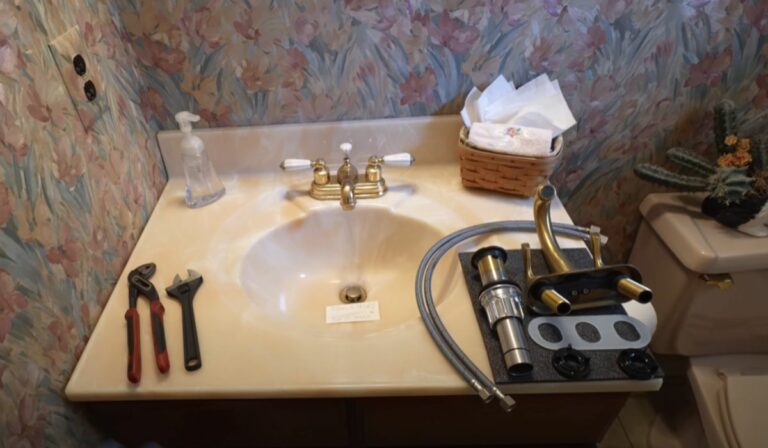How to Install a Wall Mounted Floating Shower Seat
To install a wall-mounted floating shower seat, start by locating and marking your wall studs with a stud finder to ensure strong support. Use a level to position the mounting bracket evenly, then drill pilot holes into the studs. Secure the bracket with heavy-duty screws, avoiding drywall anchors for safety. Attach the seat per instructions, then test it for stability by applying firm pressure. To ensure lasting safety, periodically check and maintain the hardware. Keep going to find out how to choose the right seat and tools for your space.
Selecting the Ideal Floating Shower Seat for Your Bathroom
When choosing a floating shower seat, consider your bathroom’s size, style, and how you plan to use it. If space is tight, opt for a foldable model to keep your shower area open when not in use.
Match the seat’s material and finish with your existing fixtures—wood adds warmth, while stainless steel offers a modern touch. Think about weight capacity and durability to ensure safety and longevity.
Also, consider comfort features like contoured edges or padded seats if you’ll spend extended time sitting. Keep maintenance in mind; look for water-resistant materials that won’t easily mold or rust.
Tools and Materials Needed for Installation
After selecting the perfect floating shower seat, gathering the right tools and materials will make your installation smoother and safer. You’ll need a power drill with various drill bits, a stud finder, a level, and a tape measure to ensure precise placement. Have a pencil handy for marking drill points.
Depending on your wall type, use appropriate anchors or heavy-duty toggle bolts to support the seat securely. A socket wrench or screwdriver will help tighten bolts properly. Don’t forget safety gear like gloves and goggles to protect yourself during drilling.
Finally, keep the mounting hardware that comes with your seat close by, along with a silicone sealant to waterproof any drilled holes. With these tools and materials ready, you’re set for a confident installation.
Finding and Preparing the Wall Studs
Since the floating shower seat must support your weight securely, locating the wall studs is crucial. Use a stud finder to scan the wall where you plan to install the seat. Move it slowly, marking each stud’s edges with a pencil.
Studs are typically spaced 16 or 24 inches apart, so confirm you’ve found the correct locations by measuring between marks.
Once you’ve marked the studs, check for any plumbing or electrical lines behind the wall using a wire detector to avoid damage.
Next, remove any tiles or wall coverings where the seat will mount, exposing the stud surface. Lightly sand or clean the area to ensure a solid connection.
Now your wall studs are ready to receive the mounting hardware safely and securely.
Mounting the Floating Shower Seat Securely
Although mounting the floating shower seat may seem straightforward, securing it firmly to the wall studs is essential for safety. First, align the seat’s mounting bracket with the studs you located earlier. Use a level to ensure the seat will sit perfectly horizontal. Mark the screw holes on the wall through the bracket.
Next, drill pilot holes into the studs to prevent wood splitting. Then, attach the mounting bracket securely using heavy-duty screws designed for structural support. Avoid using drywall anchors, as they won’t hold the weight.
Once the bracket is firmly in place, attach the seat according to the manufacturer’s instructions, verifying all connections are tight. Properly securing the seat ensures it can support weight safely and lasts over time without loosening.
Testing and Maintaining Your Shower Seat
Once you’ve securely mounted your floating shower seat, it’s important to test its stability before regular use. Apply firm pressure by sitting down gently, ensuring the seat holds your weight without any wobbling or shifting.
If you notice any movement, double-check the mounting hardware and wall anchors.
For maintenance, clean the seat regularly with a mild, non-abrasive cleaner to prevent soap scum and mildew buildup.
Inspect the mounting bolts and brackets every few months to confirm they remain tight and corrosion-free.
Address any rust or damage immediately to avoid compromising safety.
Frequently Asked Questions
Can a Floating Shower Seat Support Heavy Weights Safely?
Yes, you can safely rely on a floating shower seat for heavy weights if you properly secure it to wall studs using strong anchors and follow the manufacturer’s weight limits. Always double-check the installation for maximum safety.
Are Floating Shower Seats Suitable for Small Bathrooms?
Yes, floating shower seats are perfect for small bathrooms since they save floor space and create a minimalist look. You’ll enjoy added convenience without crowding your shower area, making your bathroom feel more open and functional.
How Do Floating Shower Seats Affect Bathroom Aesthetics?
Floating shower seats enhance your bathroom aesthetics by creating a sleek, modern look and saving space. They keep the area open and clutter-free, making your bathroom feel larger and more inviting without compromising style or functionality.
What Are the Best Materials for Floating Shower Seats?
You’ll want durable, water-resistant materials like teak, cedar, or marine-grade plywood for floating shower seats. Stainless steel or aluminum brackets ensure strength, and waterproof cushions add comfort without compromising style or longevity in your shower space.
Can Floating Shower Seats Be Removed Without Wall Damage?
Yes, you can remove floating shower seats without wall damage if you carefully unscrew them and patch the holes properly. Using anchors and proper installation techniques helps minimize damage when taking the seat off later.
Conclusion
Now that you’ve chosen the perfect floating shower seat and securely mounted it to your wall studs, you’re ready to enjoy both comfort and safety in your bathroom. Remember to test the seat’s stability before each use and perform regular maintenance to keep it sturdy and clean. With the right tools and careful installation, your new shower seat will provide lasting support and convenience, making your shower experience more relaxing every day.

